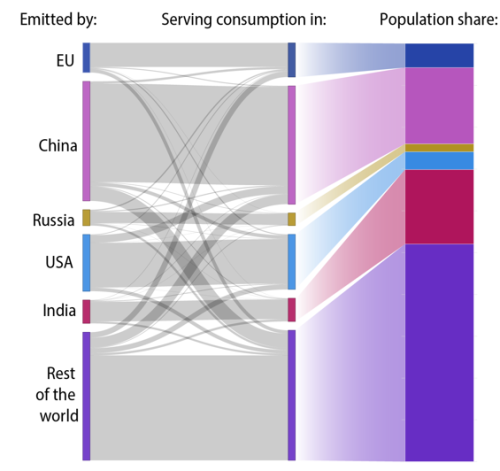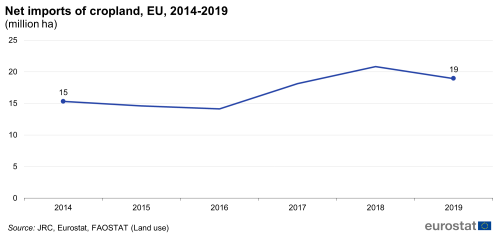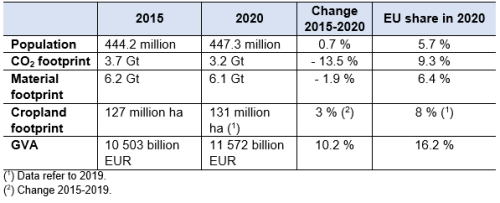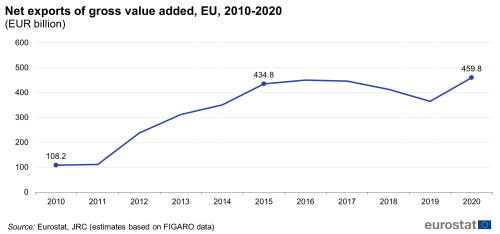Estimating spillover effects of EU consumption
Data extracted in April 2022.
No planned article update.
Highlights
This article is a part of a set of statistical articles, which are based on the Eurostat publication ’Sustainable development in the European Union — Monitoring report on progress towards the SDGs in an EU context — 2023 edition’. This report is the seventh edition of Eurostat’s series of monitoring reports on sustainable development, which provide a quantitative assessment of progress of the EU towards the SDGs in an EU context.
Full article
Summary
In a globalised world, countries’ actions towards sustainable development may positively or negatively influence other countries and their capacity to achieve the SDGs. Measuring spillover effects is therefore important for designing policies with positive impacts beyond domestic borders. This article builds upon consumption-based methods for measuring spillover effects embedded in international trade. The aim is to quantify the EU’s spillovers expressed as trade balance (imports minus exports) and to show whether they have increased or decreased over time.
Carbon dioxide (CO2) footprint: In 2020, 9.3 % of global CO2 emissions could be traced back to the EU’s consumption. In recent years, the EU has been a net importer of CO2 emissions, meaning that the emissions embodied in imported goods and services for the EU’s consumption have been higher than the emissions embodied in the EU’s exports. Between 2015 and 2020, the EU’s net imports of CO2 emissions increased, meaning the negative spillover effects of the EU’s consumption on other countries have increased.
Material footprint: In 2020, EU inhabitants consumed 6.4 % of raw materials used globally. The EU was also a net importer of raw materials, meaning that more of the materials needed for EU consumption were extracted outside the EU than the EU exported to third countries for their consumption. Since 2015, the EU’s net imports of raw materials have decreased, meaning there has been a reduction in the negative spillover effects of the EU’s consumption on other countries.
Land footprint: Three types of land footprints are analysed in this chapter: cropland, grassland and forestry land. In 2019, crops cultivated for the EU’s consumption constituted about 8 % of the global cropland. Between 2014 and 2019, the EU was a net importer of cropland, with net imports increasing by around 25 % over the period. Moreover, in 2019, the EU needed only around 2 % of the global grassland for its consumption, but around 7 % of the worldwide forest area.
Gross value added (GVA): Total GVA induced by EU consumption in 2020 was nearly EUR 11 600 billion. In the same year, the GVA generated in the EU as a result of consumption outside the EU was higher than the GVA induced in non-EU economies, making the EU a net exporter of GVA. Since 2015, the net balance between GVA resulting from EU imports and exports has also increased.
The analysis in this chapter shows a mixed picture regarding the developments in the EU’s spillover effects on other parts of the world. On the one hand, positive spillovers in the form of GVA increased over the short-term period, while negative effects of the EU’s consumption of raw materials decreased. On the other hand, EU consumption continues to affect environmental conditions in the rest of the world, and some of these effects have intensified, as shown by the increases in the CO2 and the cropland footprints.
To put the EU’s emissions and consumption into perspective, the data are compared with the EU's share of the global population. In 2020, the EU’s population was 447 million people, which equalled 5.7 % of the world population, compared with 6.0 % five years before [1].
Introduction
To end poverty, protect the planet, and ensure that by 2030 all people enjoy peace and prosperity, it is not enough for only a few countries in the world to achieve the SDGs. Instead, the 2030 Agenda must be fulfilled by the entire international community. In a globalised world, countries’ actions towards sustainable development may positively or negatively influence other countries and their capacity to achieve the SDGs [2]. Therefore, governments and societies need to consider the impacts that their domestic policies and behaviour may have beyond national borders, to avoid negative environmental, social and economic externalities and to foster sustainable development on a global scale [3]. The impacts that activities in one sector, region or country have on other sectors, regions or countries are called spillover effects (or simply ‘spillovers’). Spillovers may be a result of deliberate transboundary actions, such as official development assistance (ODA), or an unintended consequence of domestically focused policies or of the consumption of natural resources embodied in trade [4].
International spillovers have the capacity to either foster mutual sustainable development or to hinder individual countries’ efforts towards achieving the SDGs. Therefore, measuring and understanding international spillovers is of high importance for designing sustainable development strategies with positive impacts beyond domestic borders. Different organisations and researchers have used different methods for calculating spillovers. Prominent methods prioritise consumption-based over production-based accounts [5], thereby focusing on international environmental, social and economic impacts that are driven by domestic consumption.
International trade in goods and services is one of the most important triggers of international spillovers, both negative and positive. Trade generates jobs in exporting countries and is a crucial source of income and economic activity. Trade and investment liberalisation promote the transfer of environmentally sound technologies, and trade also provides incentives to companies to apply higher environmental and social standards in their business models and supply chains. However, trade also drives negative spillovers that may counteract countries’ efforts to achieve the SDGs. For example, environmental spillovers occur when countries import commodities that generate high levels of greenhouse gas emissions in the country where they are made, instead of producing these (and the emissions) themselves. Thus, the importing countries avoid domestic emissions and the emissions are attributed to the producing countries. Eliminating child labour and forced labour as well as ensuring that labour rights are respected along the supply chain are further challenges.
The aim of this article is to quantify the EU’s spillovers, put them into perspective by comparing them with other world regions and to show whether the EU spillovers expressed as trade balance (imports minus exports) have increased or decreased over time. The chapter is written from a perspective that, when it comes to environmental spillovers, countries should strive to minimise their footprint and achieve a net balance of zero in their trade. Thus, the analysis presented here largely focuses on the question of balance, while the total amount of the EU’s consumption and production and its negative impacts are discussed in other parts of the report, especially in the article on SDG 12.
Spillover effects in this chapter are measured by four indicators: CO2 footprint, material footprint, land footprint and gross value added (GVA). CO2 footprint and GVA have been estimated with the FIGARO multi-regional input-output model [6] while material and land footprints use different, less detailed models. For more information please see the explanatory note on the Eurostat website. The analysis below is structured around the four indicators. First, each indicator is explained, then the EU’s share in global emissions and consumption is discussed, and finally, the development of the EU’s spillovers over time is presented.
CO2 footprint
The CO2 footprint, or carbon footprint, measures carbon dioxide emissions classified by final use of products in the EU. In other words, it measures the amount of CO2 emissions that can be traced back to consumption within the EU’s borders. It comprises both the emissions originating in the EU and those originating abroad but serving the EU’s consumption. The CO2 footprint has been estimated using the FIGARO input-output model.
In 2020, 9.3 % of the global CO2 emissions could be traced back to the EU
Comparing the EU with other economies of the world puts the effects of EU’s consumption on other countries into perspective. In 2020, the EU’s population was 447 million people, which equalled 5.7 % of the world population in that year [7]. At the same time, as shown in Figure 1, 9.3 % of the global CO2 emissions could be traced back to the EU’s consumption in 2020 [8]. This indicates that the EU generates a disproportionally high share of the world’s emissions when compared with its share of the global population.
However, a similar pattern can also be seen for the other main economies of the world. With a population of 1.42 billion, China’s share of the world population was 18.2 % in 2020, however, its consumption accounted for a third (30.4 %) of the world’s emissions in that year. An even larger discrepancy between the population share and the share in global CO2 emissions could be observed for the United States. While the country was home to 4.3 % of the world's population, its share in global emissions was more than three times higher, at 15.0 %. India, on the other hand, hosted 17.8 % of the global population in 2020, but caused only 6.3 % of global CO2 emissions. The rest of the world (excluding China, EU, the USA, India and Russia) accounted for more than half (52.1 %) of the world population, while only 35.5 % of global CO2 emissions could be attributed to these countries in 2020.

Source: Eurostat, JRC (estimates based on FIGARO data as well as (demo_gind) and https://population.un.org/wpp/)
Almost a third of the CO2 emissions serving EU consumption are generated outside of the EU
As illustrated in Figure 1, most of the CO2 emissions serving consumption in the world’s main economies are also generated in these countries, meaning that none of these countries is generating more emissions abroad than it does domestically.
In 2020, 2.3 gigatonnes (Gt) or 70 % of the total CO2 emissions serving the EU’s consumption were generated in the EU, while 0.9 Gt of global CO2 emissions serving EU consumption originated from non-EU countries. From these non-EU countries serving EU’s consumption, China had the largest share with 0.21 Gt or around 22 %. This reflects that China is the EU’s main trading partner for imports: in 2020, the share of EU total imports (in value) originating from China amounted to 22.4 % [9].
In 2020, Russia accounted for 0.11 Gt CO2 emissions serving the EU’s consumption [10], followed by the United States (0.07 Gt) and India (0.04 Gt). Notably, while embodied emissions from Russia exceeded those from the US, the share in the value of US imports in total EU imports was higher (11.8 %) than from Russia (5.5 %) [11]. This might be explained by the fact that a substantial part of imports from Russia were semi-manufactured low-value products such as steel [12], which generate relatively high CO2 emissions during their production.
The EU’s CO2 footprint increased between 2015 and 2020
Between 2015 and 2020, the CO2 emissions embodied in imported goods and services for the EU’s consumption had been higher than the emissions embodied in the EU’s exports, making the EU a net importer of CO2 emissions. In 2020, the volume of CO2 emitted in the rest of the world serving EU consumption stood at 0.9 Gt, while 0.5 Gt CO2 were emitted by the EU economy for the production of goods that were exported to the rest of the world. This resulted in a net import of 0.4 Gt of CO2 emissions in 2020.
Since 2010, the physical trade balance of the EU’s CO2 footprint has improved, decreasing by 35.5 % between 2010 and 2020 (see Figure 2). This indicates that in 2020 the EU’s consumption caused less spillover effects than ten years before. However, this progress was mostly achieved between 2010 and 2016. In the short-term period between 2015 and 2020, the EU’s net imports increased by 6.9 %, despite a 22.9 % drop in net imports in 2020 due to the pandemic. This growth in net imports of CO2 emissions between 2017 and 2019 was driven by an increase in imports and a simultaneous decrease in exports.
Material footprint
The material footprint, also referred to as raw material consumption (RMC), shows the amount of materials required along the supply chains of the goods and services finally consumed in a country. Eurostat estimates the material footprint by calculating the actual weight of materials extracted to produce the traded goods — the so-called raw material equivalents (RME) of imports and exports — instead of the weight of the goods crossing country borders. In other words, the weight of processed goods traded internationally is converted into the corresponding raw material extraction that was required to make them. This is typically two to three times more than the actual weight of the exported goods.
Since the material footprint is able to capture resources used along international supply chains for the production of final goods, it is a useful tool for assessing spillovers in material consumption. It highlights the increasing spatial separation of production and consumption and the relocation of environmental impacts associated with material extraction. All raw materials extracted and used worldwide are allocated to domestic final consumption. Thus, outsourcing of material-intensive extraction and processing does not reduce a country’s overall material footprint. The material footprint is measured with the help of single region input-output modelling.
The EU consumed 6.4 % of the world's raw materials in 2020
In 2020, the EU population consumed 6.1 Gt of raw material, which corresponds to 6.4 % of the raw material consumed globally. The EU’s share of global raw material consumption was thus only slightly above its population share. Of all the raw materials serving the EU’s consumption, 3.9 Gt or around 64 % were extracted in the EU, while 2.3 Gt were extracted outside the EU’s borders. This means that around one-third of the raw materials needed for EU consumption were imported.
Net import of raw materials has decreased since 2015 in the EU
In 2020, the EU was a net importer of raw materials, meaning that more of the materials needed for its consumption were extracted outside the EU (2.3 Gt) than it exported to third countries for their consumption (1.4 Gt).
Figure 3 shows that the trade of raw materials in the EU had become more balanced between 2010 and 2020. While in 2010 net imports of raw materials for EU consumption constituted 1.2 Gt, this value dropped to 0.8 Gt in 2020 – a decrease of around 30 %. Between 2015 and 2020, net imports decreased by around 22 %. Over this period, the strongest drop occurred in 2020, when net imports fell by almost 23 % compared with the previous year, most probably a result of the COVID-19 pandemic.

Source: OECD, Imprint [13], Eurostat (env_ac_rme)
Land footprint
The land footprint — or virtual land — refers to the estimated amount of land needed to produce one unit of a given final product consumed in a country, regardless of where in the world the land was. Land footprints highlight the EU's dependency on foreign land embodied in goods and services consumed within the EU. While land use itself does not show concrete and direct environmental impacts, it may serve as a proxy for the pressure on ecosystems and biodiversity stemming from production and consumption systems in a given country. There are three different land footprints included in this chapter, modelled based on land use coefficients of imported agricultural products: cropland used to cultivate crops, grassland used to produce meat and dairy products, and forestry land used to produce timber. Cropland and grassland together constitute the farmland footprint.
In 2019, crops cultivated for the EU’s consumption utilised 8 % of the global cropland
In 2019, the EU consumed crops cultivated on an equivalent of about 130 million hectares (ha) of cropland located both inside and outside the EU, representing about 8 % of the world's cropland. Crops produced within the EU's borders required 70 million ha of land, while 60 million ha outside the EU were used for crops serving EU consumption. At the same time, crops exported by the EU required around 41 million ha of cropland. The discrepancy between the imported and exported cropland makes the EU a net importer of around 19 million ha of cropland, which is about 17 % of EU cropland and about the size of Belgium, the Netherlands, Denmark and Austria together.
In the same year, the EU needed 52 million ha of grassland for its consumption, which was only 2 % of the worldwide grassland. Almost all of that grassland (48 million ha or 92 %) was located within the EU borders, and 4 million ha were exported. Grassland is mainly used to feed livestock. However, since EU livestock are also fed with significant amounts of fodder crops produced on cropland, this number does not reflect the total land use embodied in EU consumption of livestock products. As the EU is a net importer of cropland, a certain amount of this imported cropland may also be used to sustain livestock-rearing in the EU.
The global farmland footprint (cropland and grassland combined) of EU consumption was around 183 million ha in 2019, which represented around 4 % of farmland worldwide. Producing the agricultural products imported by the EU required around 64 million ha of farmland, while the rest of the world consumed products requiring 44 million ha of farmland in the EU. The EU was consequently a net importer of around 20 million ha farmland, corresponding to around 12 % of EU farmland. Hence, in absolute terms, each EU resident consumed agricultural products that required more than 1 400 m² of farmland located outside the EU, while people in the rest of the world required around 60 m² of EU farmland per person [14].
About 109 million ha of forest land equivalents in the EU were used for timber production in 2019, representing 6 % of worldwide productive forest area. Around 40 % of the timber produced was exported, serving consumption in the rest of the world. The forest land embodied in these exports, however, only made up some 2 % of non-EU consumption of timber-based products. The EU consumed timber-based products associated with an equivalent of about 125 million ha of forest area, which was about 7 % of the world’s productive forest area. Almost half of the timber-based goods consumed in the EU were produced on forest land outside the EU. Producing the timber-based products imported by the EU required around 58 million ha of forest land, while the rest of the world consumed products requiring 42 million ha of EU forest land. This makes the EU a net importer of around 16 million ha of forest land, corresponding to around 15 % of its productive forest area.
The EU's cropland footprint increased between 2014 and 2019
In 2019, the EU imported crops that required around 60 million ha to grow, while crops exported to outside the EU required around 41 million ha of cropland, making the EU a net importer of cropland. Since 2014, the EU’s net imports of cropland required for cultivating crops for EU consumption have increased by around 25 %, reaching 19 million ha in 2019 (see Figure 4). This increase can be largely attributed to an increase in imported cropland over this period.

Source: JRC, Eurostat, FAOSTAT (Land use)
Gross value added (GVA)
GVA is the difference between an economy's output and the intermediate consumption, and is one of the main elements of GDP. It is a good approximation of the size of the economy from a production perspective. FIGARO data allow GVA to be estimated for economies inside and outside the EU and therefore can be used to show the economic value generated outside the EU for consumption inside the EU.
Net exports of gross value added have increased in the EU since 2015
Total GVA induced by EU consumption in 2020 was nearly EUR 11 600 billion. From this amount, around EUR 1 448 billion or 12 % were induced in non-EU economies. GVA generated in the EU as a result of consumption outside the EU was around one third higher, at EUR 1 908 billion. This makes the EU a net exporter of GVA and mirrors the export surplus of the EU economy.
Since 2010, GVA induced in the rest of the world by EU consumption has increased by around 22 %, while GVA as a result of exports to the rest of the world has increased by around 48 %. This means that the gap between GVA resulting from EU imports and exports has been widening, although the trend has slowed over the past five years.
Direct access to
More detailed information on EU SDG indicators for monitoring of progress towards the UN Sustainable Development Goals (SDGs), such as indicator relevance, definitions, methodological notes, background and potential linkages, can be found in the introduction of the publication ’Sustainable development in the European Union — Monitoring report on progress towards the SDGs in an EU context — 2023 edition’.
Notes
- ↑ Calculations based on Eurostat (demo_gind) and https://population.un.org/wpp/.
- ↑ Sustainable Development Solutions Network (SDSN) (2019), Policy Brief: International Spillovers and the Sustainable Development Goals (SDGs). Measuring how a country’s progress towards the SDGs is affected by actions in other countries.
- ↑ Joint Research Centre-European Commission (2021), Understanding the Spillovers and Transboundary Impacts of Public Policies Implementing the 2030 Agenda for More Resilient Societies: Implementing the 2030 Agenda for More Resilient Societies, OECD Publishing.
- ↑ Ibid.
- ↑ ‘Production-based’ means, for example, direct observation of CO2 emissions as they are generated, while ‘consumption-based’ refers to, for example, CO2 emissions that are generated throughout the supply chain and are hence ‘embodied’ in the products and services consumed. These CO2 emissions are generated before the products are consumed, in different locations, and scattered across supply chains that may involve many countries. To get the full picture of the net balance of a country or region in terms of inward and outward spillover effects, a combination of both approaches is needed.
- ↑ FIGARO stands for ‘Full International and Global Accounts for Research in input-Output analysis’ and comprises the EU inter-country supply, use and input-output tables (EU IC-SUIOTs). FIGARO tables are a new statistical product for economic modelling. Since 2021, they are produced annually, linking national accounts with data on business, trade and jobs for EU Member States and 18 main EU trading partners; a ‘rest of the world’ region completes the FIGARO tables. For more information on FIGARO, see European Commission, ESA Supply, use and Input-output tables: FIGARO.
- ↑ Calculations based on Eurostat (demo_gind) and https://population.un.org/wpp/.
- ↑ The estimates for CO2 emissions in the rest of the world for EU consumption presented here are higher than in the previous edition of the FIGARO data used for the 2022 monitoring report, which hampers the comparability of the data. This is due to an improved methodology to calculate CO2 emissions emitted by non-EU countries, by adding emissions from some processes that were not fully covered before. Since these emissions are an input into the FIGARO model, the emissions emitted in the non-EU countries serving EU consumption increased as well.
- ↑ Eurostat (EXT_LT_MAINEU)
- ↑ CO2 contained in energy carriers such as crude oil or gas and imported into the EU is not included in the exporting country emission account, but will show up in the importing country’s balance when combusted for power generation. The CO2 emitted in Russia for serving EU consumption is therefore not a result of Russian gas imported into the EU.
- ↑ Eurostat (EXT_LT_MAINEU)
- ↑ Eurostat (DS-018995)
- ↑ WU Vienna (2022), Material flows by material group, 1970–2019. Visualisation based on the UN IRP Global Material Flows Database, Vienna University of Economics and Business.
- ↑ Calculated using https://population.un.org/wpp/.


